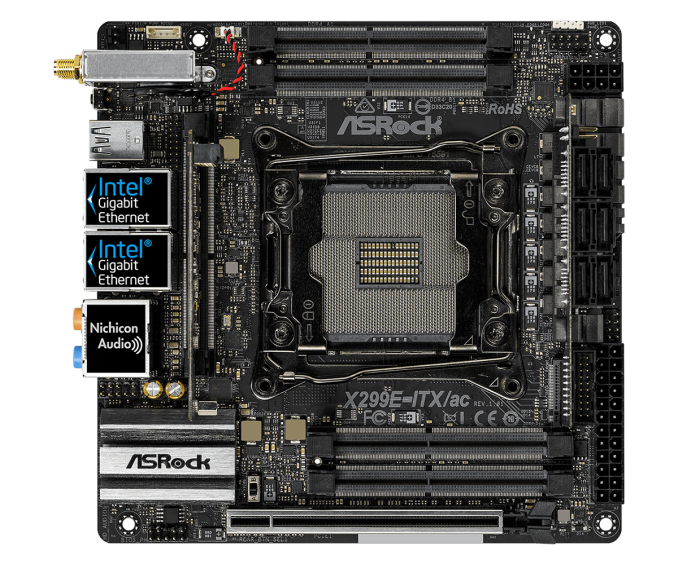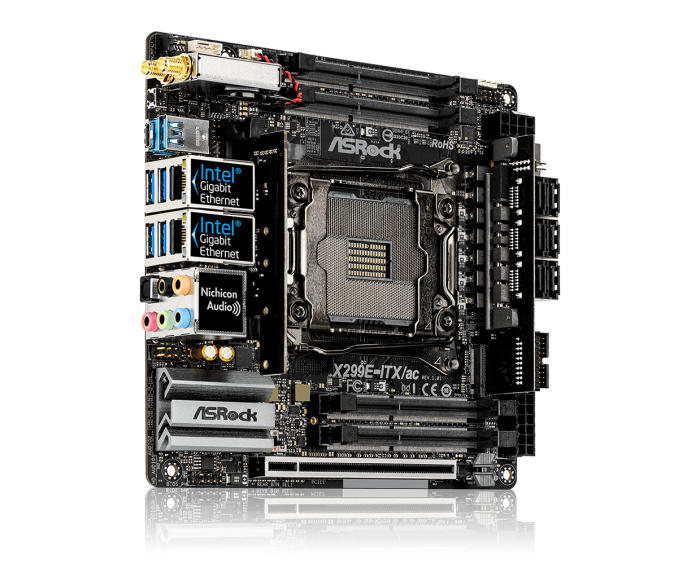The ASRock X299E-ITX/ac Motherboard Review: An 18-core No-Compromise Mini-ITX
by Joe Shields on December 4, 2017 8:00 AM ESTConclusion
The ASRock X299E-ITX/ac is priced at $399 on Newegg and lands it towards the higher end of all X299 motherboards. If we look at only the Mini-ITX space, it is in a class of it its own because it is the only ITX size board currently out for X299. It also marks the most expensive mini-ITX motherboard ever launched to consumers.
The niche this falls into is a small form factor, high horsepower, single GPU system. There are MicroATX boards available which fits the 'smaller than ATX bill', however, outside of Kaby Lake-X support and physical full-length PCIe slot count for SLI/Crossfire capabilities, the features sets between them all are quite similar with the ASRock board having the advantage of more M.2 slots and Wi-Fi compared with the micro-ATX competition. The X299E-ITX/ac requires SO-DIMM memory modules as opposed to the MicroATX boards which use full-size DRAM modules, but a quick look at pricing doesn't show too much difference.
In many cases, the small size and full-featured nature of the board gave way to a lack of aesthetic additions. For all intents and purposes, a Mini-ITX board is intended to be more functional than easy on the eyes on the first place.
To that end, the ASRock X299E-ITX brings almost everything one needs in a PC. We can argue that it might be missing some features seen on other $400 X299 boards, perhaps such as 10 GbE, U.2 support or the ability to use 128GB of RAM, but frankly, if those are build requirements, users are likely looking to a larger board in the first place.
Although Kaby Lake-X support is not found on this board, full support is provided up the stack for Skylake-X CPUs, including the Core i9-7980XE with 18 cores, 36 threads, and 165W TDP. In order to support the latest HEDT CPUs, the board requires a decent VRM and ASRock has provided just that. The parts used are fairly reasonable, with a 7-phase solution with DrMOS integrated power stages, which handled what we threw at it. That isn't to say it couldn't be improved, at least the heatsink side, which was certainly warmer than other boards that we have tested, but the system didn't fault even in our overclocks. Not only is the VRM heatsink small, but the daughterboard for SATA/USB is located directly on top of it. We are again getting out of what most would consider to be 'normal' use of such a board too.
Overclocking with the board and heatsink really wasn't an issue as we did not see throttling throughout testing. Through the hour plus of scripted testing, the heatsink was warm/hot to the touch, warmer than others by feel, but nothing alarming. Pushing things to 4.5 GHz our CPU cooling limit and running stress tests did manage to get it hot. This on an open test bench, which might be a more favorable scenario, although we did not apply any significant airflow over the situation. Stuffing this inside a SFF case and trying to overclock would more than likely lead to higher temperatures on the VRM and potential throttling. Good internal airflow or spot cooling is recommended if users are to really keen on this board in a small case with an overclock.
New to this review are the SO-DIMM memory sticks used. GSkill sent us 4x8 GB DDR4-3800 sticks which the board handled without issue by simply enabling the XMP profile.
Overall, there isn't much to complain about, at least without considering the size of the board in the first place. For the vast majority of users looking for a Mini-ITX size board, it has most of features found on the X299 based motherboards. We can nitpick about some features being missing, but given the size it is difficult to hold it against this board. An option that might be worth examining for the future might be partitioning the audio to a separate riser card.
The ASRock X299E-ITX/ac is, at the moment, a one of a kind motherboard for X299 in the Mini-ITX form factor. We are not sure if others will be coming out with some later, but if users require Skylake-X CPUs in an ITX format, this is the only choice. It does come at a price premium, at almost $400, but for a motherboard less than half the size of ATX it has nearly all the features of larger motherboards, and in some cases even more, and is able to command such a premium.
The Recommended by AnandTech Award
The ASRock X299E-ITX/ac
Mini Yet Mighty: A New Standard for 18-Core Small Form Factor Motherboards













24 Comments
View All Comments
dgingeri - Monday, December 4, 2017 - link
Of course there are compromises. The processor has 44 PCIe lanes, and only 16 are able to be used thanks to there only being one slot. Even with the riser card and the M.2 slots, there are still compromises with this.Samus - Monday, December 4, 2017 - link
I've had the ASRock X99 ITX for two years. The sole compromise is literally one PCIe x16 slot, which is all 95% of people in the market for this board need. If you need more, you go ATX. Nobody is building ITX systems with SLI or mining in mind. Nobody. With the exception of maybe one SFX PSU, they can't even drive more than one high end videocard with a platform like this, and if you are using a case that holds an ATX PSU, why are you even considering an ITX board? The whole point of the system is to be compact.In other worse, this X299 follow-up is simply amazing. 9 native storage device ports on an ITX board is unheard of. Many ITX boards still have just 4 SATA ports (which, again, is all most people in the market for an ITX system are looking for since most cases will lack more than 4 storage bays.)
Gadgety - Monday, December 4, 2017 - link
"If you need more, you go ATX."Well, yes and no. I know there are users who have used the x99 with bifurcation, in those 5%. I'd like a small pc in with a top of the line gpu and need a pci-e x1 for an additional feature. The trend for small PCs certainly seems to be growing, so offering additional pci-e possiblities on small M-ITX would be nice, whether through official bifurcation possibilities or other means. I checked the potential to using an M.2 port for a pci-e card, but couldn't find an adapter.
Vatharian - Monday, December 4, 2017 - link
I am so sad that DTX didn't took off. Just a tiny little bit of real estate, most of cases already have two slots for wide GPUs, and so much more options. If this board been DTX with 2x 16x ports, Titan Xp SLI would have been possible out of the box (albeit with water cooling, of course). Or stuff powerful storage controller in one and decent 10G or 40G network card in the other port. Or stuff really anything int he other slot.Gigaplex - Monday, December 4, 2017 - link
There's always micro ATX. It's not that different to DTX.Actae0n - Monday, December 4, 2017 - link
You certainly raise a good point. However, there are some cases, such as the Fractal Design Nano S (pretty sweet case, I might add), that only support Mini-ITX and can hold an ATX PSU.dgingeri - Monday, December 4, 2017 - link
It was not my point that it didn't have a use, but rather that the article is titled "The ASRock X299E-ITX/ac Motherboard Review: An 18-core No-Compromise Mini-ITX" when in fact there is a compromise in order to get to the form factor. I don't like people stating "no compromise" when in fact there is compromise in something.tim851 - Monday, December 4, 2017 - link
The single PCI-E x16 slot is not a compromise, it's A FEATURE. That's what you buy an ITX board for.Mr Perfect - Monday, December 4, 2017 - link
Yeah, calling out ITX for only having one PCIe slot is kind of missing the point of ITX.mnoi - Wednesday, December 6, 2017 - link
I agree, the two usb-c ports should have been thunderbolt enabled at the very least.